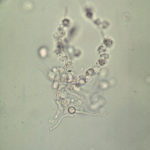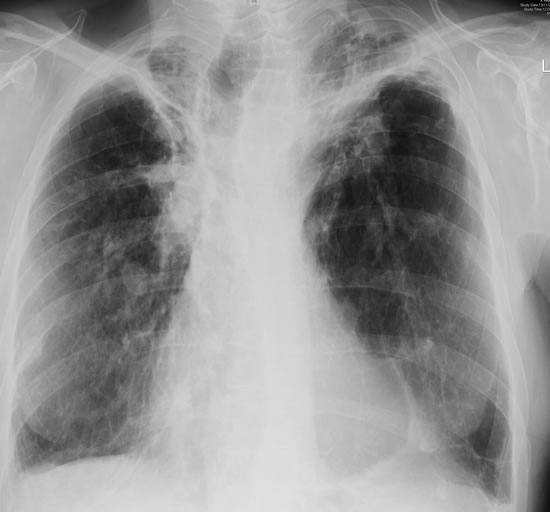Date: 26 November 2013
Born 75 years ago, Pt HK had 3 episodes of tuberculosis as a child and teenager, being treated with PAS and streptomycin. He suffered a ‘bad chest’ all his life and retired aged 54. Presenting with worsening and more frequent chest infections, he was referred with ‘bronchiectasis and Aspergillus sensitisation’. A diagnosis of chronic pulmonary aspergillosis was made in June 2009 on the basis of his chest radiograph and strongly positive Aspergillus precipitins (IgG antibodies) (titre 1/16). He also had Pseudomonas aeruginosa colonisation. His oxygen saturation was 87% and his pO2 6.8, pCO2 6.2 KPa.
His chest radiograph (see above, November 2009) was reported as showing; “ The lung fields are over-inflated. Bilateral apical fibrotic change secondary to old TB. No cavity seen.” At clinic, bilateral apical cavities were seen, with some associated pleural thickening at the left apex, without any evidence of a fungal ball.
He started posaconazole 400mg twice daily with therapeutic levels at subsequent visits. Sputum cultures never grew Aspergillus. Over the following 9 months he had no chest infections requiring antibiotics, his breathlessness worsened gradually and he remained easily fatigued. His Aspergillus antibody titres fell. Overall he felt better, but was concerned about declining respiratory status.
Copyright:
Fungal Research Trust
Notes: n/a
Images library
-
Title
Legend
-
Domestic crossbred cat with disseminated aspergillosis. Diff Quik stained squash preparation of material obtained from thoracotomy of a 3 year old domestic crossbred cat with invasive Aspergillus fumigatus infection. The cat had marked enlargement of the hilar lymph nodes that resulted in a partial tracheal obstruction. This smear was made from portions of the hilar lymph node resected at thoracotomy. Magnification x 132.
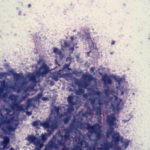
-
English Pointer with nasal aspergillosis. Diff Quik stained cytological smear of material obtained from the frontal sinus of a 7 year old English Pointer with nasal aspergillosis. This infection was caused by Aspergillus fumigatus. Fungal hyphae are beautifully demonstrated by the Diff Quik stain. Magnification x 200.
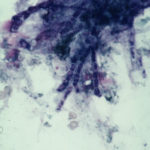
-
Nasal aspergillosis in a Schnauzer. Histological section of fungal plaques removed surgically from the frontal sinus of a 5 year old Schnauzer with nasal aspergillosis. This infection was caused by Aspergillus fumigatus. H & E; x 200.

-
Disseminated aspergillosis in a German Shepherd. Masses of fungal hyphae in the renal pelvis of both kidneys in a young German Shepherd dog with disseminated Aspergillus terreus infection.
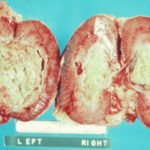
-
Nasal aspergillosis. KOH preparation of fungal plaques surgically removed from the frontal sinus of a Schnauzer with nasal aspergillosis due to Aspergillus fumigatus.
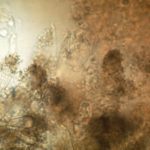
-
English Pointer with nasal aspergillosis. English Pointer with nasal aspergillosis treated by topical enilconazole injected through surgically inserted indwelling plastic tubes.

-
German Shepherd with disseminated aspergillosis. Unilateral pyelonephritis in a German Shepherd dog with disseminated Aspergillus terreus infection.
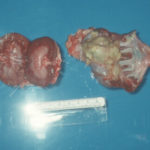
-
Rottweiler treated with indwelling plastic tubes. Photograph of a Rottweiler crossbred dog treated with indwelling plastic tubes placed surgically into the nasal cavity and frontal sinuses.

-
Rottweiler crossbred dog with nasal aspergillosis. A Rottweiler crossbred dog with nasal aspergillosis due to Aspergillus fumigatus infection. Note the loss of pigment below the nostril on the worst affected side – this finding is suggestive of a diagnosis of chronic nasal aspergillosis in the dog.
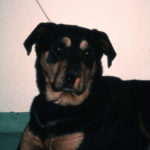
-
Disseminated aspergillosis in a German Shepherd. Hyphae of Aspergillus terreus in the urine of a young German Shepherd dog with disseminated aspergillosis. White blood cells are present in addition to the fungal hyphae. Wet preparation of urine; magnification x 132.
